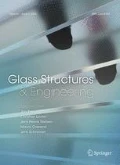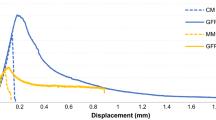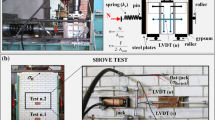Abstract
The main advantage of solid bricks over hollow blocks is substantially higher compressive strength. On the other hand, solid bricks have much higher thermal conductivity, which would lead to major heat loss when used for exterior walls. Masonry pillars and walls are usually loaded in compression and/or bending resulting from the eccentricity of vertical load or wind load. In case of solid glass bricks, compressive strength is about ten times higher than tension strength therefore the limiting factor of the glass masonry is tensile stress resulting from the bending. Whether compared to ceramic or concrete bricks masonry, the glass bricks have a smooth and non-absorbent surface and the adhesion of the mortar to the glass surface is the critical parameter. Presented paper is focused on the experimental investigation of mortar applicable for glass brick masonry with regard to use for load bearing brick walls or columns. Shear, compression and tension tests have been recently performed. Shear and tension resistance and failure modes of brick bed joint were determined during series of tests using various mortar composition, two types of surface treatment and different thickness of the mortar joint. Significant influence of the joint thickness on the resistance was found. The compression tests were performed on two small pillars to determine the compression resistance and failure mode of glass bricks walls and pillars. In parallel to these tests, several small-scale tests have been performed to determine flexural and compressive strength of hardened mortar.





























Similar content being viewed by others
References
Christoph, P., Knut, G.: Innovative glass joints—the 11 March memorial in Madrid. In: Bos, F., Louter, C., Veer, F. (eds.) Challenging Glass: Conference on Architectural and Structural Applications of Glass, pp. 113/668. IOS Press (2008)
EN 1015-11:1999: Methods of Test for Mortar for Masonry—Part 11: Determination of Flexural and Compressive Strength of Hardened Mortar. European Committee for Standardization, Brussels (1999)
EN 1052-3:2002: Methods of Test for Masonry—Part 3: Determination of Initial Shear Strength. European Committee for Standardization, Brusel (2002)
Fíla, J., Eliášová, M., Sokol, Z.: Glass masonry-experimental verification of bed joint under shear. In: IOP Conference Series: Materials Science and Engineering (2017). https://doi.org/10.1088/1757-899X/251/1/012097
KNAUF: Flexkleber weiss: Bílé elastické cementové lepidlo pro náročnější aplikace. KNAUF PRAHA s.r.o., (in Czech)
Machalická, K., Eliášová, M.: Adhesive joints in glass structures: effects of various materials in the connection, thickness of the adhesive layer, and ageing. Int. J. Adhes. Adhes. 72, 10–22 (2016)
MAPEI: Nivoplan: indoor and outdoor levelling mortar for walls and ceilings for thicknesses from 2 to 20 mm. MAPEI S.P.A. http://www.mapei.com/public/GB/products/151-nivoplan-gb.pdf. Accessed 1 July 2018
MAPEI: Planicrete: Synthetic-rubber latex to improve the adhesion of cement mixes. MAPEI S.P.A. http://www.mapei.com/public/COM/products/701-planicrete-gb.pdf. Accessed 1 July 2018
Oikonomopoulou, F., Bristogianni, T., Veer, F., Nijsse, R.: The construction of the Crystal Houses façade: challenges and innovations. Glass Struct. Eng. 3, 87–108 (2017). https://doi.org/10.1007/s40940-017-0039-4
Petrie, E.M.: Handbook of Adhesives and Sealants, 2nd edn. McGraw-Hill, New York, pp. 763–804. ISBN 00-714-7916-3 (2007)
SAKRET: Vetromalta: Zdící a spárovací malta pro skleněnétvárnice. SAKRET CZ k.s. (in Czech)
Acknowledgements
This research was supported by grant CTU No. SGS16/136/OHK1/2T/11 and by Grant No. GA16-17461S of the Czech Science Foundation. In addition, the authors are grateful to company Vitrablok, s.r.o. for the co-operation and providing the glass bricks for the experiments.
Author information
Authors and Affiliations
Corresponding author
Additional information
Publisher's Note
Springer Nature remains neutral with regard to jurisdictional claims in published maps and institutional affiliations.
Rights and permissions
About this article
Cite this article
Fíla, J., Eliášová, M. & Sokol, Z. Experimental investigation of mortar mechanical properties for glass brick masonry. Glass Struct Eng 4, 127–141 (2019). https://doi.org/10.1007/s40940-018-0085-6
Received:
Accepted:
Published:
Issue Date:
DOI: https://doi.org/10.1007/s40940-018-0085-6




